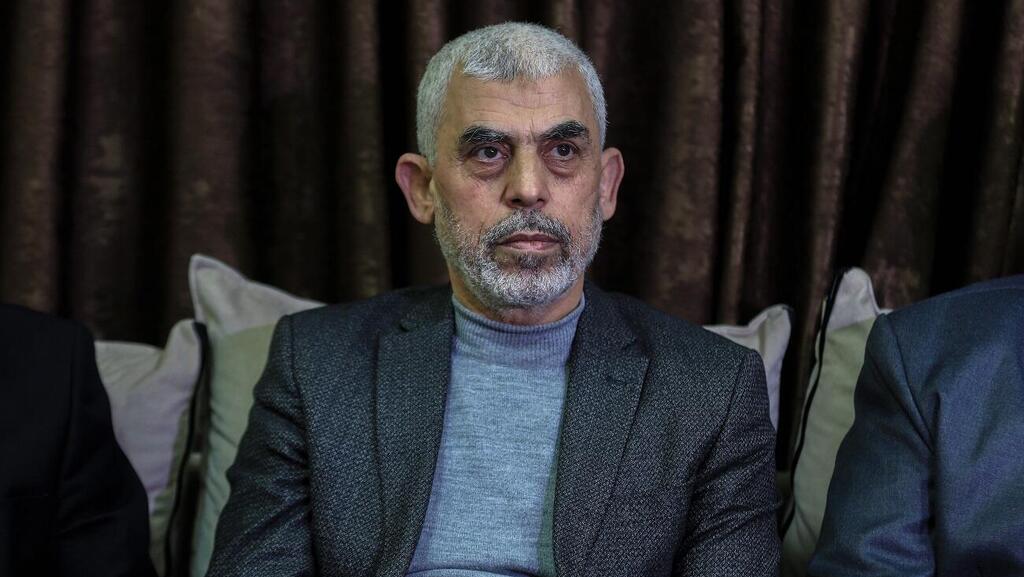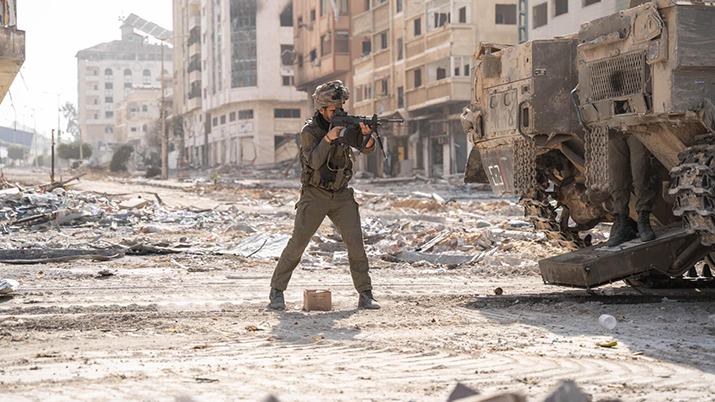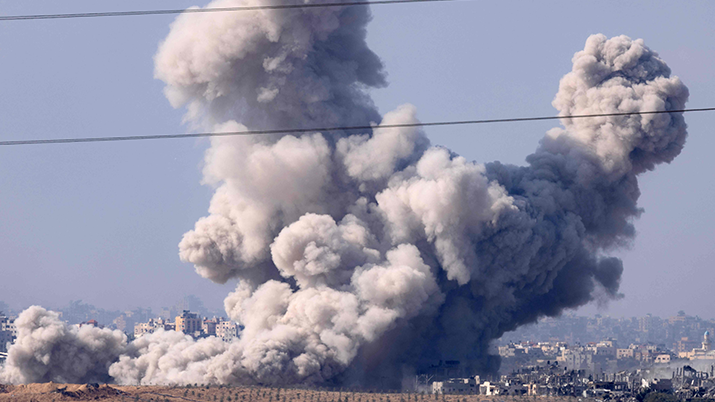Sometime toward the end of 1998, arch-terrorist Yahya Sinwar, then a prisoner in an Israeli prison, came up with a novel idea. With two cellmates, Hamas terrorists, Rouhi Moushtahaand Tawfik Abu Naim, Sinwar planned to kidnap an Israeli soldier from the Gaza Strip – then still under full IDF control and, through a tunnel, smuggle him into Egypt.
The idea was inspired by lessons learned by Hamas: The terrorist organization had kidnapped the soldier, Nachshon Waxman, and had held him captive in a secret hide-out in the West Bank. When Israeli intelligence identified Waxman’s location, the IDF’s General Staff Reconnaissance Unit, Sayeret Matkal, was sent on a daring mission to free him.
13 View gallery
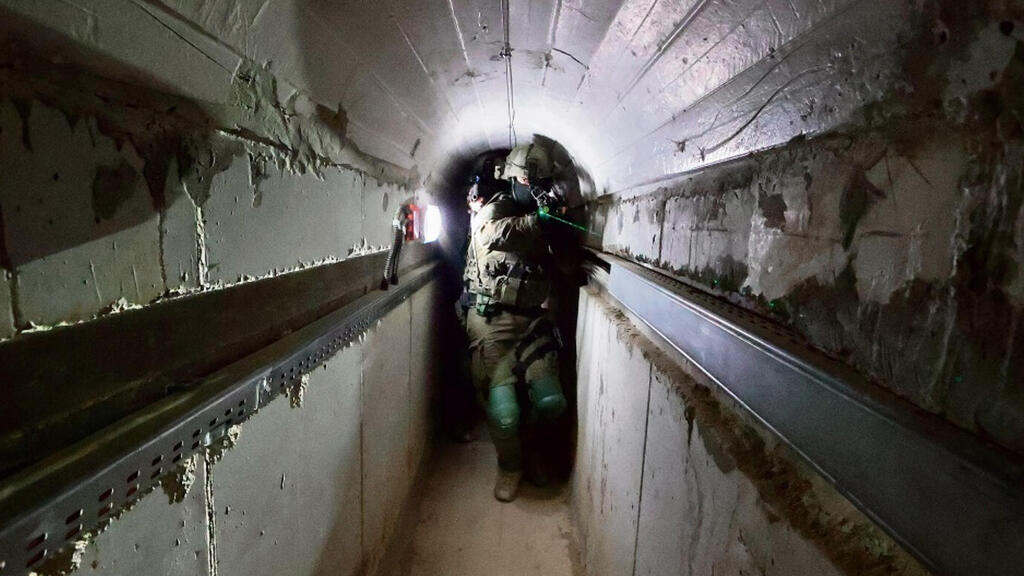

IDF forces training for combat in underground tunnels
(Photo: Gadi Kablo)
Both Waxman and Sayeret combatant, Nir Poraz, were killed. Sinwar didn’t want to repeat the Waxman mistake. He then thought back to a different hostage, captured in a country other than Israel – who had thus fell off the Israeli intelligence radar – Ron Arad.
With direct permission from Hamas’ leader, Sheikh Ahmed Yassin, the three terrorists led by Sinwar, from prison, started planning an abduction operation. At their orders, Hamas operatives in the Rafiah area were sent to dig a tunnel beneath the perimeter fence with Egypt. Although tunnels had existed here before, they had generally been for criminal smuggling. Sinwar’s tunnel was Hamas’s first terror tunnel.
The following year, Israeli intelligence discovered the tunnel exposed Sinwar’s tunnel. Inside, they found rail tracks with carriages, a lighting system, ventilation pipes, and telephone lines. It was 25 feet underground and 250 feet long – then a record in Gaza. The IDF, clearly, prided themselves on discovering the sophisticated tunnel and thwarting a kidnapping.
24 years later, Yahya Sinwar, Hamas prime minister in Gaza and de facto leader of the movement rules a vast underground system built underneath the whole of Gaza. It includes command and control rooms, communication ventilation and systems, fuel, water, and food storage facilities, concealed pits for rocket launchers, and halls for managing fighters and storing military equipment. An underground city of terror.
Sinwar himself is currently hiding in one such underground space -as Prime Minister Netanyahu put it this week “A little Hitler in a bunker.” From here, Sinwar commands the campaign against Israel. Hundreds of Hamas terrorists habitually hide in the concrete-reinforced tunnels burrowed through Gaza’s sandy ground.
Reports claim that they are prepared for a long stay, with a great deal of military equipment. Israeli intelligence believes that some of the Israeli hostages are held in the hundreds of tunnels crisscrossing Gaza, some of which were used on October 7. Yocheved Lifschitz, a hostage released by Hamas, recalled that after they were taken into the Gaza Strip, she and further hostages, walked through long tunnels before reaching a “large hall, where they gathered about 25 people. “
But Hamas’s tunnel project, or as the IDF calls it “underground system”, built over 15 years and cost over $1 billion, has become not only a hiding place for Sinwar, his combatants, and the hostages but also a strategic asset. “The serious center for Hamas warfare” as the IDF terms it, has constituted the primary threat to the IDF’s advance deep into the Gaza Strip over the past few weeks. To win the war, the tunnels are also the most significant stronghold that the IDF will have to destroy.
As luck would have it, the ground beneath Gaza is very easy to dig. It’s made up of sand mixed with clay and sandstone, a soft material that can be dug through even by the most primitive means such as hoes or pickaxes. And so, no evidence has yet been found suggesting that Hamas has been digging tunnels with mechanical equipment or engineering tools any more sophisticated than a household drill.
The abundance of cheap labor in the Gaza Strip, and the fact that, on an average day, an adult can dig 30 feet beneath the ground, means that Hamas’s tunnels project is truly hand-made.
These underground systems interconnect granting Hamas immense subterranean mobility. It’s long, hard, work that’s now giving the IDF a huge headache. “The tunnels are the hardest nut to crack in this campaign against Hamas” explains Colonel (Res.) Yossi Langotsky, who served as an advisor to the Chief of Staff for dealing with the Hamas tunnels. He further comments “For Hamas, this is their Stalingrad.”
13 View gallery
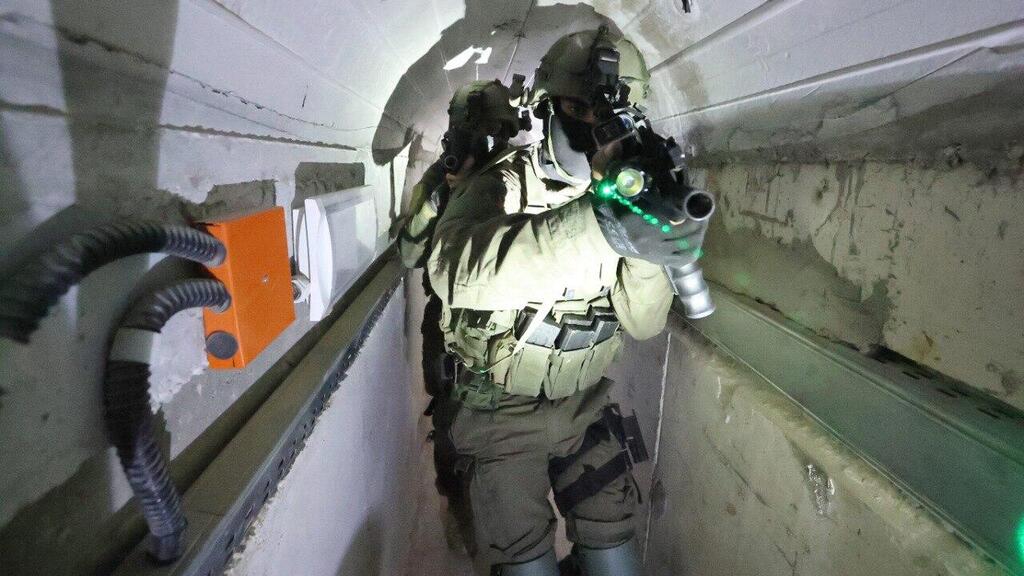

IDF forces training for combat in underground tunnels
(Photo: Gadi Kablo)
In May 2021, during Operation Guardian of the Walls, the IAF bombed what it termed Hamas’s “metro” and claimed to have “critically” damaged it. The following month, in his victory speech after the end of the operation, Sinwar announced that in Israel “they say they destroyed 60 miles of Hamas tunnels. I tell you that in the Gaza Strip, there are over 300 miles of tunnels. So, even if their story is true, they only destroyed 20% of the tunnels.” There’s no reason to think that Sinwar was lying in his speech.
We can also reasonably assume that in the two years since that speech (in which time Hamas accepted responsibility for not a single rocket fired into Israel and was focused on preparing for the murderous October 7th attack), the “metro” ruins have been repaired and that Hamas have dug yet deeper.
“But the term ‘metro’ isn’t really that good” Langotsky is keen to tell us. For years, he has warned of the impending danger posed by the tunnels. “A metro is built in straight lines, while the ‘Gaza Underground’ is a grid system including several levels, between which one can move. It wouldn’t surprise me if they’ve built elevators. They have extensive construction experience from working in Israel. They, very gradually, built an entire system allowing them to live underground for extensive periods without supplies brought in from the outside.”
” It wouldn’t surprise me if they’ve built elevators. They have extensive construction experience from working in Israel.”
Hamas goes to great efforts to conceal its underground system from the enemy. But over the years, terror organizations have invited various foreign journalists to tour the tunnels and film them from inside. Only last week, a Russian television crew got a glimpse into an Islamic Jihad tunnel.
The report shows a cable lowering the Russian journalist down a 200-foot shaft. The reporter is later seen, slightly crouching, in a horizontal tunnel with concrete walls decorated with pictures of Palestinian martyrs. Along the tunnel, Islamic Jihad combatants can be seen in full military gear.
“My soldiers are waiting here for the battle with the Israeli army,” an Islamic Jihad commander tells the reporter. “This is just one of many tunnels we’ve prepared for the Israeli attack.” He also says that the tunnels allow his forces to keep firing rockets at Israel. “We’re prepared for several months of fighting.”
Most Hamas and Islamic Jihad tunnels, like the one shown in the report, are 5 feet high and over 6 feet wide. Some tunnels are much wider and can even hold vehicles. Hamas also has more sophisticated tunnels with drainage systems, power generators, communications, and medical systems which host workshops for ammunition production and reservoirs of thousands of gallons of fuel that the organization has accumulated underground, as well as advanced weapons.
The tunnels are invariably accessed via civilian homes, allowing Hamas terrorists to walk the streets in civilian clothing, and then go down into a tunnel to equip themselves with weapons and uniforms. In the tunnels, Hamas also has equipment for rocket and mortar launching, observation capabilities, intelligence gathering, sharpshooting, and bomb-making.
Nukhba forces, Hamas’s elite unit, developed a special fighting method of kidnapping soldiers, successfully exercised in Operation Protective Edge in 2014 by kidnapping soldiers, Oron Shaul and Hadar Goldin.
Hamas’s decision to dig underground makes sense. Following years of fighting Israel above ground, when Israel had the upper hand regarding gunfire and observation points, Hamas decided to burrow tunnels that would eliminate Israel’s advantage – just as the Vietcong’s “tunnel rats” put to the test America’s great, yet clumsy, army.
Hamas’s method of doing battle is demonstrated in a video uploaded last week in which a fighter is seen coming out of a tunnel entrance, camouflaged with tree branches, and quickly running toward an Israeli Merkava tank in the Gaza Strip. The terrorist then places an explosive device on the tank and runs back into his hole. A few seconds later, a loud explosion is heard as smoke billows out of the tank – that doesn’t seem to have been seriously damaged.
In a further video, released two days later by the IDF spokesperson, IDF soldiers expose what appears to be the tunnel from which the attempted attack was launched. Hamas terrorists also sometimes come out of such tunnels to fire anti-tank missiles at Israeli tanks and armored personnel carriers, or launch offensive drones. It amounts to advanced technology coupled with digging holes in the ground.
This deadly game of cat and mouse, in many ways, characterizes the current warfare in Gaza. Hamas waited for Israel’s ground invasion before billeting most of their fighters underground, waiting for the IDF to get to them. The IDF is primarily destroying these entrance and exit shafts which are above ground and so easier to handle.
In their efforts to destroy the tunnel shafts, when entering any neighborhood or village, IDF forces spend a great deal of time locating them. This first stage is intelligence-based which, unlike that available before October 7th, as the war goes on, is proving accurate. The shafts known to intelligence are marked on maps that are shared by all ground forces, and efforts are currently underway to reach them all.
Forces reaching any site are briefed to search for new shafts unknown to intelligence. IDF sources claim that hundreds of such shafts have been found in every conquered neighborhood. Some are hidden beneath schools or mosques.
13 View gallery
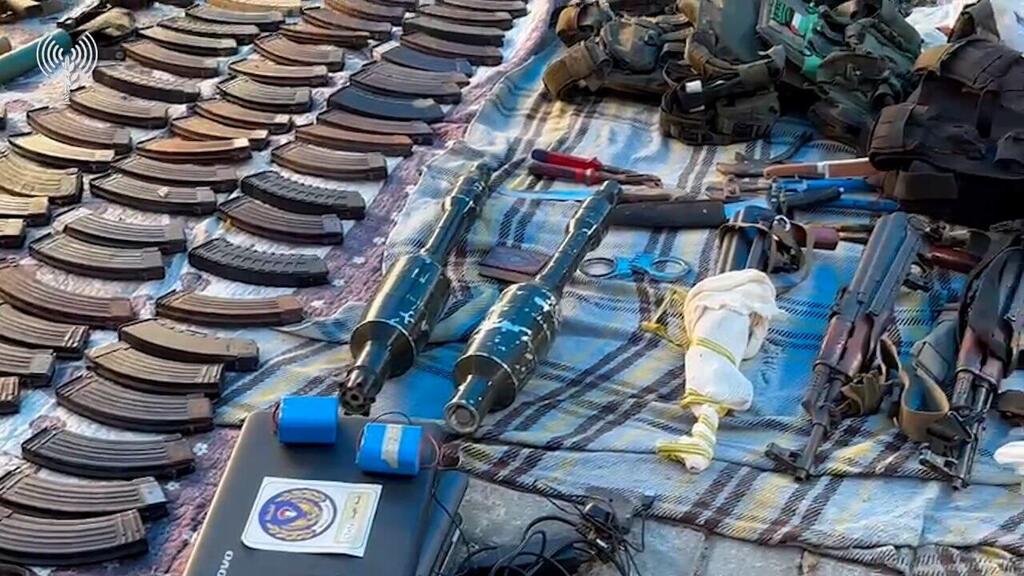

Military equipment found by IDF in Gaza tunnel pits
(Photo: IDF Spokesperson’s Unit)
This comes as no surprise, considering that Hamas places its important underground complexes beneath public institutions such as hospitals and UNRWA offices because they know that the IDF will refrain from attacking them. The IDF claims that the Izz ad-Din al-Qassam Brigade’s main headquarters are located beneath Shifa Hospital.
When a shaft is located, explosives are lowered into it, causing the shaft to collapse. These explosions often create “geysers” of dust from inside the ground, sometimes reaching 100 feet from the explosion site itself, bearing witness to the sheer extent of the tunnels.
When the IDF moves onto the next stage, we can assume that the tunnels will be investigated by lowering into them technological devices such as robots and cameras or deploying the Yahalom, the Combat Engineering Corps’ underground platoon.
“Hamas has the capability to move around fighters, hostages, and anything else underneath the ground, carry on firing rockets, leave the tunnels, and attack Israeli armored corps and infantry.”
Right now, however, the goal is blocking the shafts, trapping terrorists inside the tunnels, and making their lives as difficult as possible. The assumption in the army is that, as time goes on, more and more companies of Hamas terrorists will break under the harsh underground living conditions and will decide to lay down their arms and come out of the tunnels.
The IDF’s approach has thus far proven itself. The army takes pride in its rate of progress and relatively low causality numbers, compared to the ground operations’ first days. The IDF will not have achieved its goal even if it rules the whole of the Gaza Strip above ground if Hamas men are still underground.
“Hamas knew the IDF would enter the Gaza Strip after October 7, and they planned for it,” says Guy Aviad, Hamas researcher and author of “Lexicon of the Hamas Movement”. “Hamas has the capability to move around fighters, hostages, and anything else underneath the ground, carry on firing rockets, leave the tunnels, and attack Israeli armored corps and infantry. This must be decisive for the campaign to be decisive. We keep talking about ground operations, but we need to talk about underground operations.“
The tunnels started off in the aftermath of the peace agreement with Egypt and Israel’s withdrawal from Sinai following the division of the city of Rafiah, a move that split families. The first tunnels were dug to enable families from either side of the border to meet up. These tunnels were short and dug close to the surface and did not require ventilation or support systems.
In the next phase criminal elements, mainly from the southern end of the Gaza Strip, recognized the tunnels’ business potential. “Market gaps between Egypt and Israel meant that one could buy cheaply in Egypt, smuggle goods through the tunnels, and sell high in Israel. So, they started building smuggling tunnels” Aviad tells us.
He says that the first massive use of the tunnels for smuggling began during the first Intifada as the IDF exerted more pressure on organizations in the Gaza Strip. “In those years dozens of terrorists, some very senior, started escaping to Egypt via these tunnels,” he says.
At the end of the ‘90s, Hamas started digging tunnels designed for terrorist attacks, like the one Sinwar planned from prison. A breakthrough came during the 2000-2005 Al Aqsa Intifada which, unlike the first Intifada, was based not only on civil disturbances such as throwing stones and Molotov cocktails, but also employed live fire.
“When there’s a serious conflict going on, the need arises for as many weapons as possible to be brought into the Gaza Strip,” Aviad explains. “And then, the tunnels at Rafiah get upgraded and become the main smuggling route for weapons, turning Gaza into one big arsenal.”
At this time, these tunnels became weapons in their own right: While the IDF controlled the Philadelphia Corridor on the Gaza-Egypt border, Hamas started digging terror tunnels underneath the outposts along the border. 14 IDF soldiers were killed in 2001-2004 attacks on these outposts.
In 2004, armed terrorists infiltrated the Erez Crossing via a tunnel, killing an IDF soldier. Following the 2005 disengagement, Hamas also started digging “offensive tunnels”, i.e. tunnels from Gaza into Israeli territory. In 2006, Gilad Shalit was kidnapped by the use of one such tunnel.
Until 2000, Hamas tunnels generally reached a depth of 40 feet and didn’t require internal support. As Hamas experimented with deeper tunnels, some started collapsing, burying both diggers and terrorists. Hamas then began lining the tunnels with wooden constructions, and then moved onto concrete. Recent pictures of the tunnels show them lined continuously with these concrete slabs, allowing them to become longer and stronger.
Over time, both communication systems within the tunnels and Hamas’s mental abilities to spend extended periods in them improved. The tunnels were equipped with ventilation systems – pipes extending to the surface, complete with bellows pumping oxygen underground – a kind of “snorkel.”
The threat of the tunnels, mainly the terror tunnels that attacked IDF outposts along the Philadelphia Corridor, forced the IDF to respond. In December 2004, then Chief of Staff, Moshe “Bogie” Ya’alon appointed geologist and former senior Military Intelligence Directorate official, two-time recipient of the Defense Ministry’s Israel Defense Prize Col. (Res.) Yossi Langotsky as his advisor regarding tunnels.
Langotsky performed the role on a completely voluntary basis. “When I started working and I spoke to people dealing with it in the army, they told me that they were digging tunnels in Gaza to a maximum depth of 30 – 60 feet” recalls Langotsky. “I explained that in Gaza, you can dig as far as the water table, and that in the area in question, that’s 100 – 230 feet.”
“The enemy’s success in realizing the objectives of the tunnels and the relative simplicity of their use, constitute an acceleration that will increase their use.”
From what Langotsky said this week, we understand that the security establishment was not very keen on his conclusions regarding the tunnels. In his 2005 report presented to the chief of staff, entitled “Summary of the Tunnels Threat Study”, Langotsky tried chiming all the warning bells.
“The enemy’s success in realizing the objectives of the tunnels and the relative simplicity of their use, constitute an acceleration that will increase their use by the enemy,” wrote Langotsky in what now reads like a self-fulfilling prophecy of doom.
“It appears that the geological conditions from the ground surface down to the water table (up to 230 feet) can be mined… experience has proven that the enemy is operating on this front with insight, patience, sophistication, and determination,” Langotsky said this week that his report fell on deaf ears. “The security establishment did not prioritize with required professionalism.”
Langotsky even presents a file containing 132 pages he accumulated over the years, entitled “The Tunnels Threat – a Strategic Timebomb”, containing correspondence with various state sources regarding the tunnels. They were generally ineffective.
Langotsky cites the Geophysical Institute of Israel’s address to the minister of defense back in 2001, in which the institute offered security officials support in combatting the tunnels. Langotsky says that instead of adopting the expertise of the institute, which is a government company, Defense Ministry officials did not have the sense to set up any kind of fruitful collaboration. “The defense establishment ignored it,” he says. “I hope the commission of inquiry after the war will investigate this episode.“
Following Operation Protective Edge, the attorney general also published a report regarding the tunnels, in which he concluded that only at the end of 2013, after the exposure of three Hamas offensive tunnels that year, “did the Military Intelligence Directorate significantly increased its’ addressing the tunnels threat, despite the tunnels being dug years earlier. The severity of the threat was known.”
The attorney general further discovered that the personnel allocated to ground forces for discovering weapons and mapping and destroying tunnels in enemy territory was extremely limited at the junior levels. Until mid-2013, there was only one section head dealing with the issue, and that was only a part-time position.
Israel’s neglect wasn’t just with regard to the offensive tunnels that proved deadly for IDF soldiers during Operation Protective Edge. The defense and logistic tunnels created by Hamas within the Gaza Strip also do not seem to have received sufficient attention from the defense system either.
In 2014, following Operation Protective Edge, Langotsky gave a television interview, once again declaring his prophecies of doom, saying. “Another thing that must serve as a warning to us – just as the Vietcong in Vietnam built entire cities underground, Hamas has built a system of tunnels inside the Gaza Strip. Any ground force entering the Gaza Strip will run into these tunnels.” This has also proven accurate.
Prof. Yoel Raskin tried to arouse the IDF from its slumber regarding the tunnels. A geologist and geomorphologist from the Department of Geography and Environment at Bar Ilan University who, in the early 2000’s, served as a field research officer in the Southern Command.
“I started researching the tunnels at my own initiative in 2002,” he says this week. In 2003, we conducted a comprehensive survey of the tunnels for the IDF but, over the years, the army didn’t understand its significance. I, and others, begged them to conduct geological measurements and map out the tunnels in an orderly fashion – that they should note their depth, etc.
The army should have had responses – before horses bolted. It could have been done. They could have used technological, engineering, and scientific efforts and convey the message that we are in charge underground. It didn’t happen.
During disengagement, when they determined the IDF’s new deployment along the border, we presented a document explaining that although the IDF, visually, had control above ground it had no control over the skies, (i.e. firing from steep rocket launching trajectories), or beneath the ground. After Israel left Gaza, Hamas took advantage of these two dimensions.
“For Hamas, the rate at which the tunnels grew, not only in size, but also in their purpose, constituted a shift in their own perceptions of their operations” continues Raskin.” It started out with smuggling goods, moved on to arms, and then onto terror tunnels. Hamas was tactical in these phases. Later on, the tunnels became kidnapping tunnels, as used for the abduction of Gilad Shalit, and then they became offensive tunnels. The next phase was that of offensive tunnels developed during Operation Protective Edge. These new tunnels suited Hamas’s great operational appetite as Hamas saw that it always worked and that the IDF could not respond.”
In a 2020 study, titled “Underground Warfare in the Gaza Strip and the Military Complexity of Combating It”, he concludes that one can fairly assume that there is an extensive network of dozens of tunnels spanning hundreds of miles. He says that the underground obstacle built by Israel along the border, may disrupt terrorists from infiltrating Israel from underground.
It was not, however, preventing Hamas from making strategic use of the tunnels to get close to the border without being exposed. “I estimate that, in some cases, they dug as far down as the water table to use the water there, “ he said this week.
13 View gallery
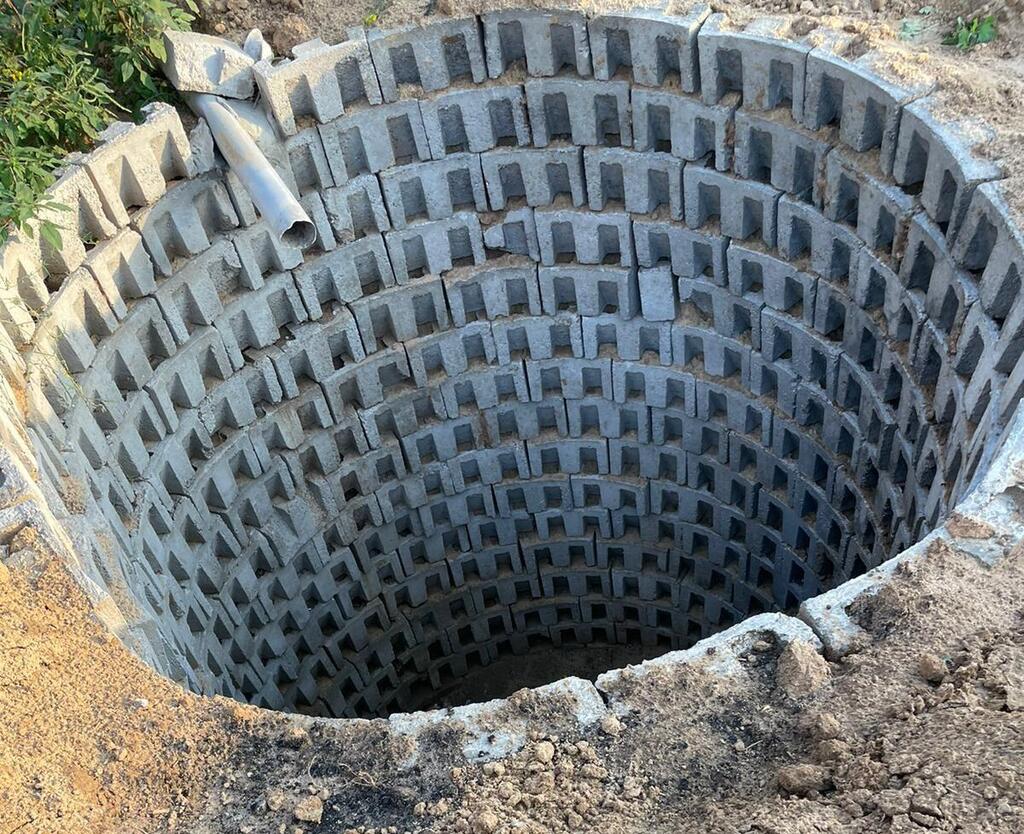

Tunnel entrance found in Gaza
(Photo: IDF Spokesperson’s Unit)
As part of his study, Raskin presents a sketch of a model of the underground system. He divides the system into three levels. “The first level is the shallow tunnels, directly connected to the shafts reaching above ground. These are important for listening and operating the steep trajectories” he says. “I believe the power generators and fuel are at the shallow level – up to 30 feet deep. “
The second level of the tunnels, at a depth of 60-90 feet, includes main mobility routes leaving from the city of Gaza in the direction of the borders with Israel, Egypt, and toward the sea. “Here is the logistic system – soldiers’ sleeping quarters, kitchens, food, bathrooms, clinics, etc,” says Raskin.
He believes that the tunnels at the deepest level, those requiring much more effort, include Hamas’s control and command cells. “I would say that the sophisticated equipment such as the drones and electronic warfare is stored here,” he says. “It’s reasonable to presume that this is the final bunker Israel will have to destroy.”
Hamas’s tunnels are not only a military tool, but also an economic machine. Hamas has earned a great deal of money through all things everything connected to the tunnels crossing the Israel-Egypt border. Hamas has been sure to charge tariffs for goods smuggled through these tunnels – including cars and electronic goods as well as brides promised to grooms across the border.
These tariffs reach an estimated 50 million shekels each month. The Hamas tunnels have, meanwhile, become something of a tourist attraction – destinations for school trips, summer camps, and even wedding pictures.
The tunnels have provided livelihoods for thousands of tunnel diggers. Hamas invariably forces Gaza residents to assist in digging the tunnels: Dozens of children used by Hamas as diggers due to their tiny body size, have been killed while digging. Some testimonies claim that diggers have been forced to work underground around the clock, while supervised by Hamas, beating them if they weren’t keeping up. Reports claim that Hamas has also executed dozens of diggers for fear of conveying intelligence to Israel.
13 View gallery
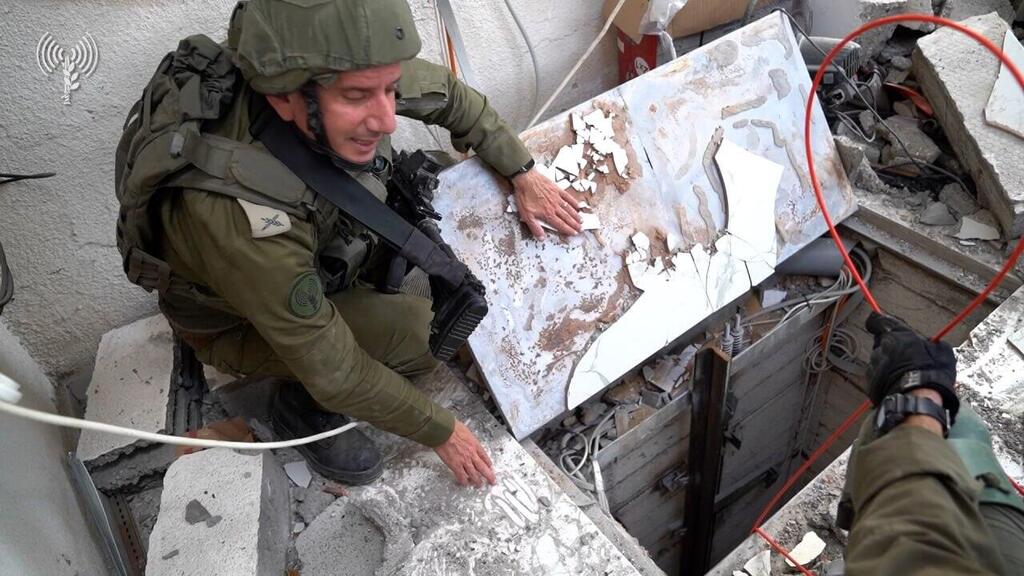

Hamas tunnel entrace located by the IDF in Gaza
(Photo: IDF Spokesperson’s Unit)
Much of the money Hamas earned through the tunnels, was reinvested in the tunneling project. At the end of 2013, when the engineering corps exposed tunnels in the Khan Younis area at the southern end of the Gaza Strip, IDF sources estimated that the tunnel was about a mile and a half long and used 25 thousand concrete blocks, weighing 800 tons.
This was just one of 30 tunnels exposed by Israel. Part of the money for the concrete came from donations transferred from Qatar and other countries. Over the years, Hamas has managed to control the cement brought into the Gaza Strip, used to build the tunnels.
Palestinian reports claim that, in the early 2010s, Hamas took sacks of high-quality cement from Turkey, emptied them out, and refilling the sacks with – probably Egyptian – cheap cement, that they passed onto Gaza residents. Gazans started complaining that their houses were due to collapse due to poor-quality cement.
Hamas’s exploitation of civilians to build the tunnels should come as no surprise: Only a few weeks ago Hamas politburo member, Musa Abu-Marzuk, admitted that the tunnels built in Gaza are designed to protect Hamas rather than the residents of the Gaza Strip.
When asked in an October 27 television interview “Since you have built 500 kilometers of tunnels, why haven’t you built bomb shelters, where civilians can hide during bombardment?”, he responded: “We have built the tunnels because we have no other way of protecting ourselves from being targeted and killed. These tunnels are meant to protect us from the airplanes. We are fighting from inside the tunnels.”
Hamas digging themselves deep underground, presently constitutes an enormous headache for the IDF that possesses technological tools and special forces designed to enter tunnels. Such a move, however, would be both dangerous and extremely complicated.
13 View gallery
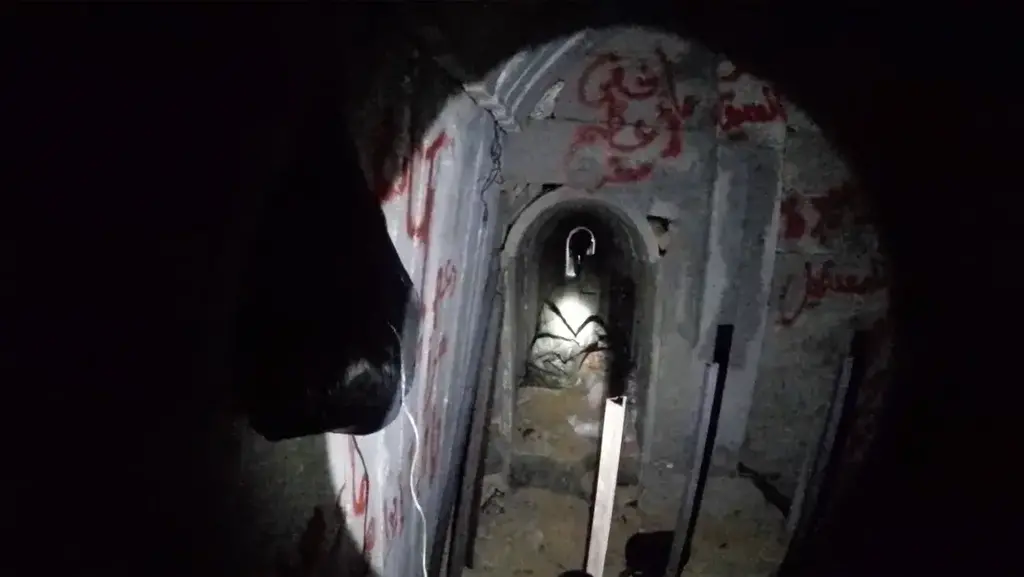

Hamas tunnels seen in footage released by CNN
(Photo: via X)
Prof. Raskin says that “the army has the capability, both from the air and the ground, to shave off the top layer of the tunnels, and from there it can start using equipment to get deeper into the tunnels. “But either way, the first phase of cleaning the tunnels is taking control of extensive areas above ground. When you’re in the field, you can create a process to learn and constantly gather intelligence regarding what’s below ground, the nature of which is unprecedented in the history of mankind. From one place to another, it’ll be about mapping, or destruction, or making life in the tunnels so hard that they’ll flee from the threat from above ground, and then we’ll catch them alive.”
“There are lots of options, but I believe that the IDF’s achievements in the end will be very impressive. You must remember that the Hamas terrorists are trapped underground. Maybe they presumed that the IDF wouldn’t make it so deep into Gaza, and are therefore not prepared for being stuck in the tunnels for such a long time, with IDF soldiers right above them,” he added.
This is further reinforced by what an officer fighting in Gaza tells us: “Although Hamas thought that underground solved their problems, it actually caused them problems” he says. “It’s a place that gives Hamas an illusion of protection. They maneuvered themselves into a space where it’s easy to destroy them. They can no longer can’t escape from the tunnels.”



